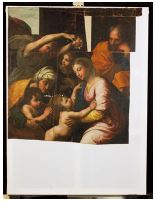Conference paper
Portsteffen, Hans Dietmar; Hünerfauth, Katharina:
Der zerschnittene ''Raffael'' – digitale Lösungen für ein fehlendes Gemäldedrittel

Hans Portsteffen, CICS
Im Kontext eines MA Projektes wurden die Einzelteile untersucht, restauriert und montiert. Es wurde deutlich, dass die Kopie wohl noch im 16. Jahrhundert entstanden ist (C14 Datierung) und sehr nah am Original orientiert ist. Die fragmentarische Situation und das vorhandene Original führten sehr bald zu der Überlegung, die großen Verluste durch eine digitale Rekonstruktion zu schließen. Damit stellen sich jedoch zahlreiche technische und ethische Fragen, die in einem weiteren Master-Projekt bearbeitet werden. Es ergibt sich eine spannende Situation: das Original ist erhalten – es kann gescannt werden. Ein digitaler Druck der zur Ergänzung benötigten Partien ermöglicht die Verwendung des Originals zur Ergänzung der Kopie – dieser digitale Druck wird zugleich auch eine Kopie.
Der Beitrag greift diese Fragen auf und erläutert die technischen Möglichkeiten der Umsetzung des Drucks, die Überlegungen zur Auswahl des Druckträgers, des Druckerverfahrens und der verwendeten Materialien, um dann auch die Fragen nach der ethischen Dimension dieser Vorgehensweise zu erörtern.
The cut up ''Raphael'' - digital solutions for a missing third of a painting
In 1518, Raphael painted the ''Great Holy Family'' for Francis I. The painting was admired early on, and numerous copies resulted from this admiration. A very early, high-quality copy of the painting, which is exhibited in the Louvre today, turned up in the 20th century at a Paris flea market, where it found an enthusiastic buyer. Given the size of the painting and the limited space of his VW Beetle, the buyer did not hesitate for long and cut the painting into five large pieces and removed the stretcher frame. The cut pieces that never came together again ended up in the CICS studios via an estate. In the transport folder, the individual parts were found in good condition, but essential parts were missing. The entire lower third of the painting has been lost for unknown reasons.
In the context of an MA project, the individual parts were examined, restored and assembled. It became clear that the copy was probably made in the 16th century (C14 dating) and is very close to the original.
The fragmentary situation and the existing original very soon led to the consideration of completing the large losses by a digital reconstruction. However, this raises numerous technical and ethical questions, which will be addressed in a further master project.
An exciting situation arises: the original is preserved and can be scanned. A digital print of the parts needed to supplement the original allows the original to be used to supplement the copy – thus, this digital print also becomes a copy.
The paper takes up these questions and explains the technical possibilities of realizing the print, the considerations for selecting the printing medium, the printing process and the materials used, in order to discuss the questions about the ethical dimension of this procedure.
Prof. Dipl.-Rest. Hans Dietmar Portsteffen Fakultät für Kulturwissenschaften, Institut für Restaurierungs- und Konservierungswissenschaft (CICS) der TH Köln, Restaurierung von Gemälden und polychromen Skulpturen
Vita
Katharina Hünerfauth M.A. bearbeitet das Gemälde als Projekt ihres MA-Studiums (und ihrer Thesis) am CICS TH Köln.